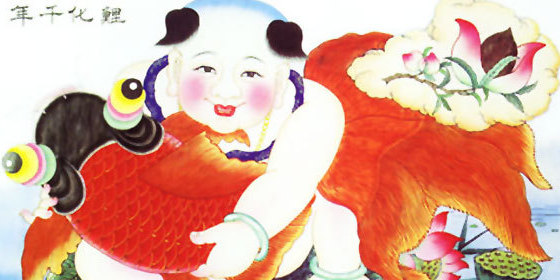Top 10 things to know about Spring Festival
 0 Comment(s)
0 Comment(s) Print
Print E-mail China.org.cn, January 9, 2012
E-mail China.org.cn, January 9, 2012
 Nian Hua (Spring Festival Picture)
Nian Hua (Spring Festival Picture)
Nian Hua (Spring Festival Picture) is a special type of painting in China. It is used during the Spring Festival.
It originated in the Pre-Qin Period (before 221 B.C.), a brief record of which can be found in Zhanguo Ce (Strategies of the Warring States Period).
As late as in the Western and Eastern Han Dynasties (206B. C. -220 A. D.), people liked to paste the images of various gods on both sides of the door, expecting them to ward off evil and usher in good luck. These images are called "the door-gods". Since people pasted them up during the Spring Festival, these pictures gained a special significance for the occasion.
The art of printing from engraved plates, which was invented in the Tang Dynasty (618-907 A. D.), brought about further development of Nian Hua. Before the Tang Dynasty, Nian Hua in most cases were images of deities and spirits.
After the Tang Dynasty, some works evolved into more realistic pictures, and the images of the door-gods turned into two generals: Qin Qiong and Yuchi Jingde. There were more Nian Hua produced in this fashion in the Song Dynasty (960-1279 A.D.), and xylographic Nian Hua, of religious themes developed gradually in the Ming Dynasty (1368-1644 A. D.).
In the Ming and Qing dynasties, xylographic Nian Hua reached a new height of development and Nian Hua came into the homes of the ordinary people. In the Qing Dynasty, most of the provinces had their own workshops for making Nian Hua.
The main producers included Taohuawu of Suzhou, Yangliuqing of Tianjin, Weifang of Shandong, Foshan of Guangdong, Mianzhu of Sichuan, Wuqiang of Hebei, Zhu-xianzhen of Henan, Shaoxing of Zhejiang, and so on.








Go to Forum >>0 Comment(s)